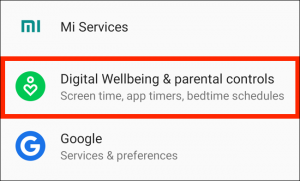As parents, we are always concerned about the well-being of our children. Kids these days spend a lot of time on smartphones. Understanding this concern of all the parents, Android has included the Digital Wellbeing feature that displays daily screen time. In fact, it gives a breakup of the time spent on each app, the number of notifications received, number of times that the user unlocked the phone, etc. Several adults also use this feature to monitor and check how frequently they use the phone or a particular app. Here is how to check your screen time on Android.
How screen time limit works
When you set a screen time limit for your child’s Android phone or Chromebook then they will be notified when:
- The feature of Screen Time is first set on the Android device
- The device they are using with Screen Time limit is about to be locked
When the device is locked, your child/user:
- Will be unable to unlock the device or use any apps
- They will be unable to see any notifications received from apps
- Will be able to make only an emergency call if there is a calling plan activated, but they will be unable to make any other calls
- They will be able to answer all incoming calls
Steps to set up Digital Wellbeing on Android
The Digital Wellbeing feature is present in the Settings of your Android phone. Here is what you need to do:
- Go to Settings of your Android phone
- Tap on Digital Wellbeing & Parental Controls
- The phone will keep a track of notifications, app usage time and the number of times of the device unlocks if you activate all the controls mentioned on this screen.
Steps to keep screen time in check
There are different ways in which screen time can be kept under check. Here are they:
App Timer
You can set a timer for all the apps you think your child or you are using. Social media platforms are addicting, and it is not just them, but we, too, tend to lose track of time while using them. A timer on the apps can ensure that you get back to work or studies on time. A timer will set a limit on how much time you get to spend on the app each day. When the time limit is up, the users get a notification about it. The app icon greys out and the users are unable to access it. They will get access only after midnight or if the timer is turned off manually. Here is what you can do to set a timer:
- Go to Settings
- Tap on Digital Wellbeing and Parental Controls
- Scroll to locate App Timers
- You will find the list of apps present on your phone
- Just beside every app, you will find ‘No Timer’ written along with a small drop-down arrow
- Tap on this drop-down arrow and select the choice of time you want to permit for app usage. You have choices from – 15 minutes, 30 minutes, 1 hour or Custom
- Make your selection and exit the page
Screen Time Goal
You can also set your screen time goal to ensure that you or your child doesn’t spend too much time on the phone.
- Go to Settings
- Tap on Digital Wellbeing and Parental Controls
- Tap on Screen Time Goal
- Your average Screen Time Goal will already be displayed. You can customize this time to set a goal to the number of hours you would like to spend on your phone
- Tap on Set to activate this feature
Unlock Goal
Another way to keep your screen time under check by keeping a count of the number of times one unlocks their phone. Here is how to activate it:
- Go to Settings
- Tap on Digital Wellbeing and Parental Controls
- Tap on Unlock Goal
- Set your unlock goal by picking a number between 0 and 500
- Tap on Set to activate the feature
Wind Down
This feature turns your screen to greyscale or blocks the notifications when you are going to bed at a certain set time.
- Go to Settings
- Tap on Digital Wellbeing and Parental Controls
- Wind Down
- On
- On this page, you will find ‘Turn on as Scheduled’ option
- You can either toggle this ON to set the Wind Down option automatically or you can set your schedule by clicking on it
- Most will want to set their time schedules according to their bedtime. You have the option to set a different schedule for every day of the week.
Parental Controls
Parental controls give you permission to manage your child’s device. You will have to link your child’s device to your phone. They must have an email that you will link to yours. There are two ways of doing it.
In the first option when you are putting parental controls, you will be prompted on who will use this device – Child or Teenager and Parent
If you select Child or Teenager then here is how you can activate controls:
- Go to Settings
- Tap on Digital Wellbeing and Parental Controls
- Scroll down and tap on Set up Parental Controls
- Tap on Get Started
- Tap on Child or Teenager
- Add your child’s email
- This will link your child’s device to yours and give you access to control how much time they spend on it every day.
If you select Parent, then you will be guided to download an app from Play Store – Family Link.
Once you have this app, you will be able to control your kids Android device:
- Go to Settings
- Tap on Digital Wellbeing and Parental Controls
- Scroll down and tap on Set up Parental Controls
- Tap on Get Started
- Tap Parent
- You will be prompted to Install Family Link – tap on Get Family Link and follow the prompts to download and install this app
- You can now control your kids’ screen time from this app
These are the easy ways on how to check your screen time on Android. The method is same for all the Android phones that have been updated to the latest version of Android 10.
Experiencing difficulties with your Device, check out our “How To” page on how to resolve some of these issues.















